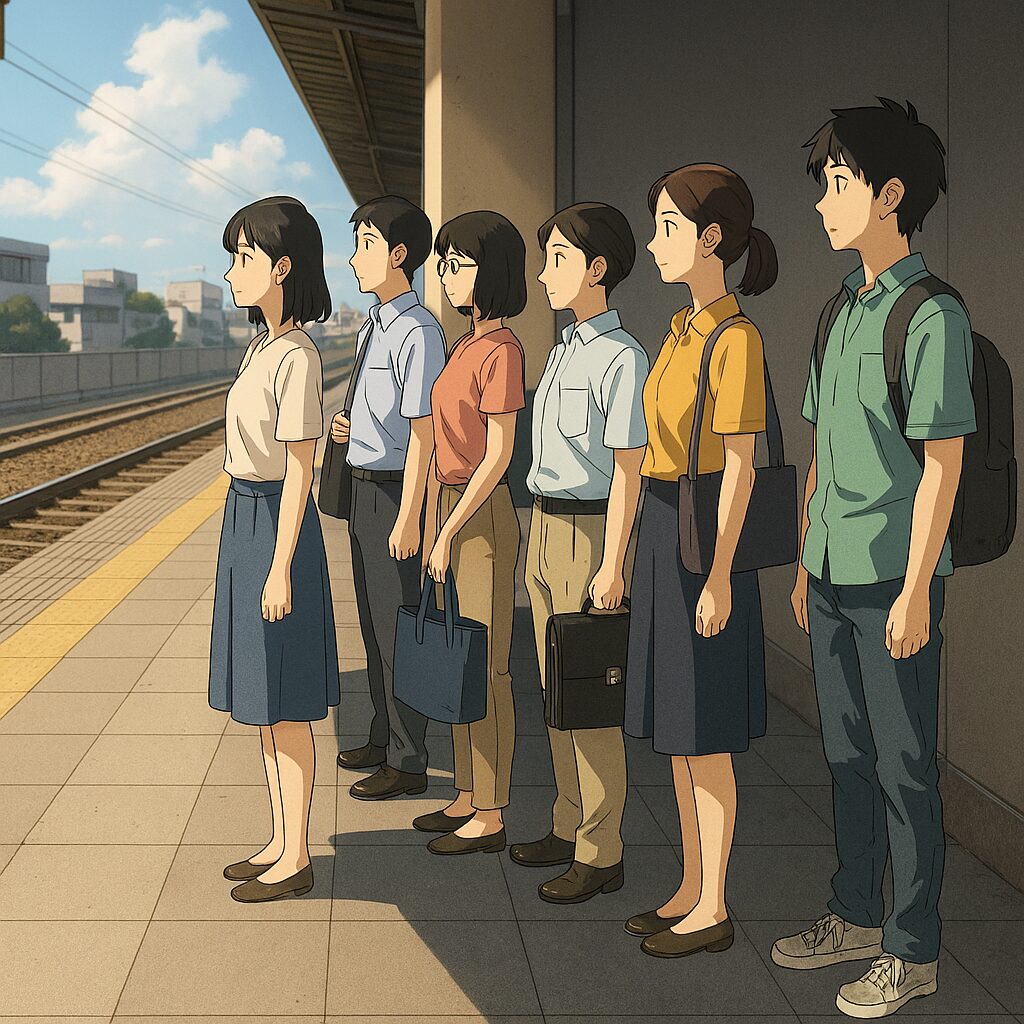The Philosophy Behind Order, Shadows, and Everyday Empathy
If you’ve ever visited Japan, you may have noticed something quietly astonishing: people lining up in perfect order, even when there’s no one watching. At train stations, they wait patiently in the shade, forming silent queues in the shadows cast by pillars or overhangs. No signs. No instructions. Just a shared understanding.
To many overseas visitors, this behavior feels almost surreal. Why do Japanese people line up so quietly—even in places where the line isn’t visible? Is it discipline? Habit? Or something deeper?
Let’s explore the cultural, historical, and philosophical roots of this phenomenon. Because behind every silent queue in Japan lies a story of empathy, aesthetics, and invisible communication.
- The Shadow Queue: A Scene from Everyday Japan
- The Aesthetics of Order: Not Just Efficiency
- Historical Roots: From Samurai to Schoolchildren
- The Invisible Thread: Empathy Without Words
- Global Comparisons: What Makes Japan Different?
- Shadows as Symbols: The Poetry of Everyday Life
- Conclusion: What We Can Learn from Japan’s Queues
- 📎 Related Reading
- 🏷️ Suggested Tags
- なぜ日本人は静かに並ぶのか?
- 影に並ぶという日常の美学
- 秩序は美しさでもある
- 歴史的背景:武士から子どもたちまで
- 言葉なき思いやりという文化
- 海外との比較:何が違うのか?
- 影に並ぶという詩的な行為
- 結び:静かな行列が教えてくれること
- 📎関連記事
- 🏷️おすすめタグ
The Shadow Queue: A Scene from Everyday Japan
Imagine a hot summer day in Tokyo. The train platform is bathed in sunlight, but a narrow strip of shade hugs the edge of a pillar. Without a word, people begin to gather in that shaded area, forming a line. No one cuts. No one complains. They simply wait.
This is not an isolated scene. It happens across Japan—at bus stops, convenience stores, elevators. The act of lining up, even in the absence of clear boundaries, reflects a deeper cultural rhythm.
The Aesthetics of Order: Not Just Efficiency
In many countries, lining up is about fairness and efficiency. But in Japan, it’s also about beauty.
The Japanese concept of “Rei” (礼)—often translated as “courtesy” or “respect”—infuses everyday actions with a sense of grace. To line up is to acknowledge others. To wait your turn is to show humility. Even the act of standing in the shadow is a gesture of consideration: “I won’t block your sun. I’ll stay out of your way.”
This quiet choreography is not enforced by rules. It’s guided by “Ma” (間)—the Japanese sense of space and timing. It’s about knowing when to move, when to pause, and how to coexist without intrusion.
👉 For a deeper dive into how Rei and Ma shape Japanese communication, check out this related article:
🧘♂️The Aesthetics of Silence: How Rei and Ma Shape Japan’s Wordless Communication
Historical Roots: From Samurai to Schoolchildren
Japan’s emphasis on order and harmony has deep historical roots. During the Edo period, social conduct was governed by strict codes of behavior. Samurai were trained not only in combat but in etiquette. The idea of “meiwaku” (迷惑)—causing trouble to others—was considered dishonorable.
In modern times, this ethos is reinforced through education. From a young age, children are taught to clean their classrooms, serve lunch to classmates, and wait their turn. These practices instill a sense of shared responsibility and mutual respect.
The Invisible Thread: Empathy Without Words
What makes Japanese queues so unique is their silence. There’s no shouting, no pushing, no verbal negotiation. Instead, there’s a kind of “wordless empathy”—a collective awareness of others’ needs.
This is where Japanese culture diverges from many Western norms. In the West, assertiveness is often valued. In Japan, attunement is prized. People sense each other’s presence, adjust their behavior, and maintain harmony—all without speaking.
This invisible thread of empathy is woven into daily life. It’s why people bow slightly when passing each other. It’s why train conductors apologize for delays measured in seconds. It’s why strangers line up in the shade, without being told.
Global Comparisons: What Makes Japan Different?
In many countries, queues are chaotic. People jostle for position. Rules are enforced by staff or signs. In Japan, the rules are internalized.
This difference stems from cultural values. Japan emphasizes group harmony (wa 和) over individual expression. The goal is not to assert oneself, but to blend in gracefully.
That’s not to say one system is better than the other. But Japan’s approach offers a compelling alternative: a society where order is maintained not by force, but by shared understanding.
Shadows as Symbols: The Poetry of Everyday Life
There’s something poetic about lining up in the shadows. It’s a metaphor for Japanese aesthetics: subtle, quiet, respectful.
In Japanese art and architecture, shadows are celebrated. The classic essay In Praise of Shadows by Jun’ichirō Tanizaki explores how darkness and subtlety create beauty. In the same way, the shadow queue reflects a cultural preference for restraint over display, presence over performance.
To stand in the shadow is to say: “I am here, but I do not need to be seen.”
Conclusion: What We Can Learn from Japan’s Queues
Japanese people don’t line up because they’re told to. They line up because they care. About others. About space. About harmony.
In a world that often feels loud and chaotic, Japan’s quiet queues offer a lesson in empathy. They remind us that order can be beautiful, that silence can be meaningful, and that even the smallest actions can reflect deep cultural values.
So next time you see a line forming in the shade, take a moment to appreciate it. It’s not just a queue. It’s a philosophy.
📎 Related Reading
🏷️ Suggested Tags
Japanese Culture, Empathy, Social Harmony, Rei, Ma, Train Station, Philosophy, Why Japan, Wordless Communication
なぜ日本人は静かに並ぶのか?
影に並ぶ秩序と日常の思いやりに宿る哲学
日本を訪れたことがある方なら、一度は驚いたことがあるかもしれません。誰に言われるでもなく、人々が静かに整列して並んでいる光景。駅のホームでは、柱の影に自然と列ができていく。案内も指示もないのに、誰もがその秩序を守っているのです。
海外の方にとっては、まるで魔法のような現象に映るかもしれません。なぜ日本人は、誰も見ていなくても、静かに並ぶのでしょうか?それは単なる習慣ではなく、もっと深い文化的・哲学的な背景があるのです。
影に並ぶという日常の美学
真夏の東京。駅のホームは強い日差しに照らされていますが、柱の影には人々が静かに並んでいます。誰も声を荒げず、誰も割り込まず、ただ黙って順番を待つ。
このような光景は、日本全国で見られます。バス停、コンビニ、エレベーター前。並ぶという行為は、日本人の日常に深く根付いています。
秩序は美しさでもある
多くの国では、並ぶことは「公平さ」や「効率性」のための手段です。しかし日本では、それは「美しさ」でもあります。
日本語の「礼(れい)」は、単なる礼儀ではなく、他者への敬意を込めた美的な行為です。順番を守ることは、他者を思いやること。影に並ぶのは、「あなたの邪魔をしない」という無言の配慮でもあります。
この静かな秩序は、ルールによって強制されているわけではありません。それは「間(ま)」という、日本独特の空間と時間の感覚によって導かれています。
👉 この「礼」と「間」が日本の無言のコミュニケーションにどう影響しているか、詳しくはこちらの記事をご覧ください:
🧘♂️沈黙の美学:礼と間がつくる日本の言葉なきコミュニケーション
歴史的背景:武士から子どもたちまで
日本の秩序と調和への意識は、江戸時代にまで遡ります。武士は礼儀作法を重んじ、他者に迷惑をかけることは恥とされました。
現代では、学校教育の中でその精神が受け継がれています。子どもたちは教室を掃除し、給食を配膳し、順番を守ることを学びます。こうした日常の中で、「みんなのために行動する」という価値観が育まれていくのです。
言葉なき思いやりという文化
日本の行列が特別なのは、その「静けさ」にあります。声を荒げることも、押し合うこともありません。ただ、互いの存在を感じながら、自然と秩序が生まれていく。
これは「言葉なき共感」とも言えるでしょう。日本では、自己主張よりも「気配を読む」ことが重視されます。相手の気持ちを察し、空気を読み、調和を保つ。それが日常の中に息づいているのです。
海外との比較:何が違うのか?
多くの国では、行列は混沌としています。スタッフや看板が秩序を保つために必要です。しかし日本では、そのルールが人々の心の中にあります。
この違いは、文化的価値観に根ざしています。日本では「和(わ)」—集団の調和—が重視されます。個人の自由よりも、全体の美しさを優先するのです。
どちらが優れているという話ではありません。ただ、日本の静かな行列は、「秩序は強制ではなく、思いやりから生まれる」ということを教えてくれます。
影に並ぶという詩的な行為
影に並ぶという行為には、どこか詩的な美しさがあります。それは、日本の美意識そのものです。
日本の建築や芸術では、影や暗がりが美として尊ばれます。谷崎潤一郎の『陰翳礼讃』では、暗さの中にこそ美があると語られています。影に並ぶ姿は、「控えめであること」「目立たないこと」の美しさを象徴しているのです。
「私はここにいます。でも、目立つ必要はありません。」
結び:静かな行列が教えてくれること
日本人が並ぶのは、誰かに言われたからではありません。それは、他者を思いやる心の表れです。
騒がしく、せわしない世界の中で、日本の静かな行列はひとつのメッセージを投げかけてくれます。秩序は美しい。沈黙には意味がある。小さな行動にも、深い文化的価値が宿っている。
次に、柱の影に並ぶ人々を見かけたら、ぜひその光景を味わってみてください。それは単なる行列ではなく、日本の哲学そのものなのです。
📎関連記事
🏷️おすすめタグ
日本文化, 思いやり, 社会的調和, 礼, 間, 駅のホーム, 哲学, Why Japan, 沈黙のコミュニケーション



コメント